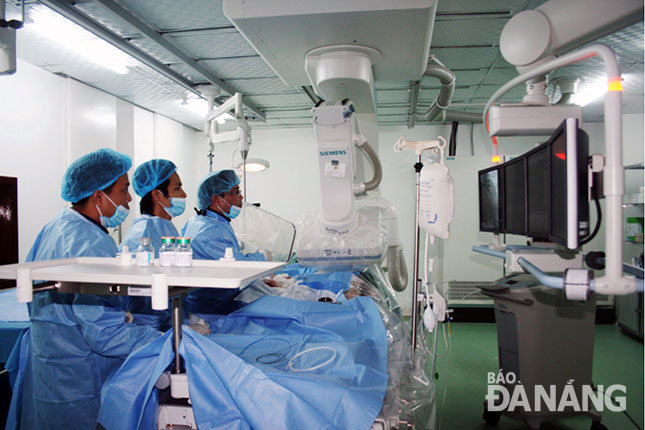C Hospital offers high-quality healthcare services with advanced medical techniques
Since mid-January, many advanced medical techniques have been successfully used in treatments at Da Nang’s C Hospital in a bid to provide better examination and treatment services to the general public.
 |
| Hospital surgeons performing surgery |
Under an ongoing bilateral cooperative programme between the Vietnamese and Japanese governments, the hospital has been equipped with 51 new advanced machines. Amongst them are an over 25 billion VND Digital Subtraction Angiography (DSA) system manufactured by Germany’s Siemens and an over 3 billion VND Intravascular Ultrasound (IVUS) system produced by the USA’s Boston Scientific Corporation.
DSA is a way of taking images of arteries, veins and organs of the body using complex computerised x-ray equipment, whilst IVUS is a medical imaging methodology using a specially designed catheter with a miniaturized ultrasound probe attached to the distal end of the catheter. Most notably, the hospital is the first medical establishment in the central region and highlands to have used these modern medical machines.
Thanks to the efficiency of using these machines, doctors from the hospital’s Cardiovascular Intervention Department have saved the lives of about 100 patients from the city and other localities in the region. In particular, patients have recovered well from successful surgery thanks to the application of advanced medical techniques during treatment.
For example, the Department’s surgeons recently performed a successful emergency surgical intervention on a 63-year-old man from Quang Nam Province’s Nui Thanh District.
The patient had been rushed to the hospital in a serious condition with unstable angina, hypertension, and dyslipidemia.
With the help of scans via the DSA and IVUS systems, the doctors detected atherosclerotic lesions in his coronary arteries. They, therefore, decided to place a wire frame of stent grafts to prevent microembolic complications in select atherosclerotic carotid lesions.
The patient has been now discharged from the hospital after only 4 days of treatment.
Over recent years, the hospital has also sent some of its qualified doctors to study abroad in order to help enhance their professional skills, and especially to learn how to utilise their modern medical equipment imported from other countries.
For example, Dr Hoang Phuong, the Head of the hospital’s Cardiovascular Intervention Department, has attended many long-term overseas courses in Canada, Japan and France.